
Abraxas sylvata, the clouded magpie, is a Palearctic moth of the family Geometridae that was named by Giovanni Antonio Scopoli in 1763.
Geshna is a monotypic moth genus of the family Crambidae described by Harrison Gray Dyar Jr. in 1906. It contains only one species, Geshna cannalis, the lesser canna leafroller, described by Altus Lacy Quaintance in 1898. It is found in North America, where it has been recorded from Florida, Mississippi, South Carolina, North Carolina and Tennessee. It has also been recorded from Costa Rica and Cuba.
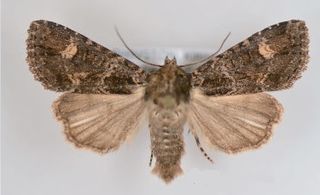
Aseptis binotata, the rusty shoulder knot moth, is a moth of the family Noctuidae. The species was first described by Francis Walker in 1865. It is found widespread in western North America, west of south-central Alberta, Wyoming, and Nebraska. Along the Pacific Coast it occurs from northern Mexico to south-central British Columbia. It can be found from sea level to altitudes over 2000 meters in a variety of habitats from dense forest to shrub desert.

Aseptis characta is a moth of the family Noctuidae first described by Augustus Radcliffe Grote in 1880. It is widespread in western North America, where it is found in the western Great Plains, Great Basin, and Pacific regions from British Columbia, Alberta, and Saskatchewan to Colorado, Utah, northern Arizona and southern California. The species occurs in dry habitats like sagebrush steppe, juniper woodlands, and open forest from sea level to 2,500 meters.

Asota caricae, the tropical tiger moth, is a species of noctuoid moth in the family Erebidae. It is found from the Indo-Australian tropics of India and Sri Lanka to Queensland and Vanuatu.
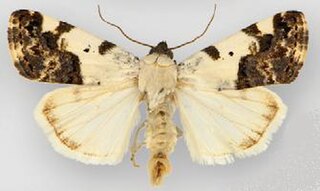
Tarache aprica, the exposed bird dropping moth, is a moth of the family Noctuidae. The species was first described by Jacob Hübner in 1808. It is found in North America from Ontario and Quebec to Florida, west to Arizona, north to Kansas and Iowa. There are some records from Great Britain, but this probably relates to imports.
Hellinsia triton is a moth of the family Pterophoridae first described by William Barnes and Arthur Ward Lindsey in 1921. It is found in the US state of Arizona.

Hellula rogatalis, the cabbage webworm, is a moth of the family Crambidae described by George Duryea Hulst in 1886. It is found from the southern United States north in the east to Maryland, New York and Ontario. It is also found in Mexico, where it has been recorded from Distrito Federal.
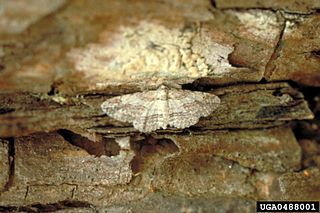
Iridopsis pergracilis, the cypress looper moth, is a moth of the family Geometridae. The species was first described by George Duryea Hulst in 1900. It is found in the US from Maryland to Florida.
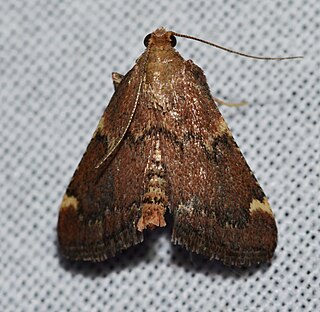
Hypsopygia intermedialis, the red-shawled moth, is a species of snout moth in the genus Hypsopygia. It is found in the United States, southern Canada and Haiti.
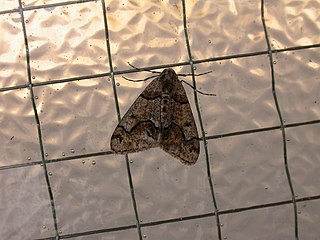
Gabriola dyari, or Dyar's looper, is a moth of the family Geometridae first described by Taylor in 1904. It is found from the Alaskan panhandle and British Columbia to California. The habitat consists of coniferous forests.

Pseudohemihyalea edwardsii, or Edwards' glassy-wing, is a moth in the family Erebidae. It was described by Alpheus Spring Packard in 1864. It is found in the United States from western Oregon and the Columbia Gorge in southern Washington south to California, in the south-west east to western New Mexico. The habitat consists of oak woodlands and mixed hardwood forests at low elevations.
Stilbosis extensa is a moth in the family Cosmopterigidae. It was described by Annette Frances Braun in 1919. It is found in North America where it has been recorded from California.
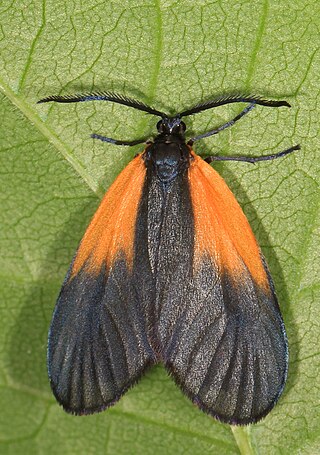
Pyromorpha dimidiata, the orange-patched smoky moth, is a species of leaf skeletonizer moth of the family Zygaenidae found in eastern North America.

Frechinia helianthiales is a moth in the family Crambidae. It was described by Mary Murtfeldt in 1897. It is found in North America, where it has been recorded from Arizona, Illinois, Manitoba, Missouri and Oklahoma, south to Mexico.
Boryzops purissima is a species of moth of the family Erebidae. It is found in the southern United States, where it has been recorded from Florida and Texas, as well as in Veracruz in Mexico, Costa Rica and Jamaica.

Agonopterix curvilineella, the curved-line agonopterix moth, is a species of moth in the family Depressariidae. It was first described by William Beutenmüller in 1889. It is found in North America, where it has been recorded from Illinois, Indiana, Kentucky, Maine, Maryland, Massachusetts, Michigan, Minnesota, Mississippi, New Brunswick, New York, Ohio, Ontario, Quebec, Tennessee, West Virginia and Wisconsin.
Ochromolopis ramapoella is a moth in the family Epermeniidae. It was described by William D. Kearfott in 1903. It is found in North America, where it has been recorded from Alberta, Illinois, Indiana, Kentucky, Manitoba, Michigan, New York, Ohio and Quebec.
Coleotechnites elucidella is a moth of the family Gelechiidae described by William Barnes and August Busck in 1920. It is found in North America, where it has been recorded from California.
Gonionota bourquini is a moth in the family Depressariidae. It was described by Clarke in 1964. It is found in Brazil and Argentina.












